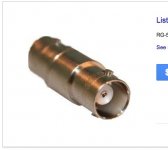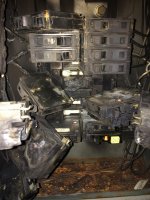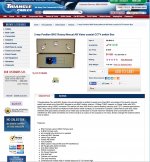Hello all.
Is a spidf connector (and wire) the same as rca?
I think not as the quality of the two I hold in my hand are different, yet similar.
Briefly, I have an audio set up.
The audio interface I use does not play nicely with other programs.
For this other program (software), I am considering purchasing and using a different interface when that software is in use.
My speakers have 3 types of inputs, s/pdif, aes, analog line.
I am using the s/pidf and would like to have the new interface also use the same s/pidf in.
My thought is to remove the s/pidf wire from my interface which is going to the speaker. Keep the other end in the speaker.
Add two s/pidf wires, one from each interface.
Then use a "s/pidf" coupling to connect either one interface or the other to the speaker.
Which brings me back to my original question kinda. Will a RCA coupling work for s/pidf wires?
Also, as this method of switching back and forth is a bit barbaric, would there be some type of single pole double throw s/pidf switch made that I could use instead to switch back and forth?
Thank you.
Is a spidf connector (and wire) the same as rca?
I think not as the quality of the two I hold in my hand are different, yet similar.
Briefly, I have an audio set up.
The audio interface I use does not play nicely with other programs.
For this other program (software), I am considering purchasing and using a different interface when that software is in use.
My speakers have 3 types of inputs, s/pdif, aes, analog line.
I am using the s/pidf and would like to have the new interface also use the same s/pidf in.
My thought is to remove the s/pidf wire from my interface which is going to the speaker. Keep the other end in the speaker.
Add two s/pidf wires, one from each interface.
Then use a "s/pidf" coupling to connect either one interface or the other to the speaker.
Which brings me back to my original question kinda. Will a RCA coupling work for s/pidf wires?
Also, as this method of switching back and forth is a bit barbaric, would there be some type of single pole double throw s/pidf switch made that I could use instead to switch back and forth?
Thank you.
I guess there's a difference.
I located orange keystone coupler.
It does mention orange and spidf, as yellow,red,greeb,white do not.
So I will order one and do the caveman.
Orange RCA Keystone Jack Coupler Female F Audio SPDIF Digital Coxial Adapter W | eBay
Any feedback on this coupling or a possible A/B switch is appreciated.
Thank you.
I located orange keystone coupler.
It does mention orange and spidf, as yellow,red,greeb,white do not.
So I will order one and do the caveman.
Orange RCA Keystone Jack Coupler Female F Audio SPDIF Digital Coxial Adapter W | eBay
Any feedback on this coupling or a possible A/B switch is appreciated.
Thank you.
I believe I read around spidf cable is 75 ohms.
This ab switch specs says 75 ohms..
Amazon.com: Cable N Wireless Gold Plated Coaxial A/B Switch for Splite TV Antenna HDTV Cable 2 Way Digital Optical Coax Splitter (US Seller): Electronics
Should it work?
Thank you
This ab switch specs says 75 ohms..
Amazon.com: Cable N Wireless Gold Plated Coaxial A/B Switch for Splite TV Antenna HDTV Cable 2 Way Digital Optical Coax Splitter (US Seller): Electronics
Should it work?
Thank you
Many thread in the digital line section talked about that few months ago.
SPIDF is a 75 ohms protocol but most of the commercial brands use 50 ohms & RCA 50 ohms plugs and chinchs. The most hearable result is a lack of definition and power in bass mid-bas range in my experience.
A simple TV cable is 75 ohms. Take male & female true 75 ohms BNC (because some 50 ohms exist also with BNC) will give you better improvement than the most expensive false digital rca cables (which are 50 ohms like the one for analog !)
note some rare 75 ohms rca exists but in any case you have to mix 75 ohms and 50 ohms in you digital line transmission. It results in a worse result than your actual all 50 ohms !
So if 75 ohms : change alls the conectors in 75 ohms for both devices and the cable (simple TV one or a good Belden if you can find it !)
SPIDF is a 75 ohms protocol but most of the commercial brands use 50 ohms & RCA 50 ohms plugs and chinchs. The most hearable result is a lack of definition and power in bass mid-bas range in my experience.
A simple TV cable is 75 ohms. Take male & female true 75 ohms BNC (because some 50 ohms exist also with BNC) will give you better improvement than the most expensive false digital rca cables (which are 50 ohms like the one for analog !)
note some rare 75 ohms rca exists but in any case you have to mix 75 ohms and 50 ohms in you digital line transmission. It results in a worse result than your actual all 50 ohms !
So if 75 ohms : change alls the conectors in 75 ohms for both devices and the cable (simple TV one or a good Belden if you can find it !)
Thanks Eldam,
I'll look for that post.
I'll do some more research to see about keeping it all spidf.
Is flopping back and for between spidf in and outs odd?
If it's going to turn into a pain in the ars, I would rather not, but will leave the spidf alone and come from a new interface to the speakers with a ts or that xlr looking connector and then switch between feeds via the speaker.
https://www.jblpro.com/www/products/recording-broadcast/lsr4300-series/lsr4328p#.U_sq7Ch8tvY
I'll look for that post.
I'll do some more research to see about keeping it all spidf.
Is flopping back and for between spidf in and outs odd?
If it's going to turn into a pain in the ars, I would rather not, but will leave the spidf alone and come from a new interface to the speakers with a ts or that xlr looking connector and then switch between feeds via the speaker.
https://www.jblpro.com/www/products/recording-broadcast/lsr4300-series/lsr4328p#.U_sq7Ch8tvY
You should use 75ohm coaxial cable. The connectors are less important. The 'correct' connector is 75ohm BNC, but RCA (which does not have a specified impedance) will do as this is not a demanding application.
Switching data streams may be OK, but watch out for clicks as the DAC resynchronises - although it may mute itself while it does this.
Switching data streams may be OK, but watch out for clicks as the DAC resynchronises - although it may mute itself while it does this.
Thank you for the reply.
BNC coupling?
Not that I doubt it but, it looks like where the hole is for the post in the spidf connector is too far back.
Also, there are the posts which come out of the sides of the coupling.
Will it work? Do the posts get snipped off or cut.
Yes, currently the interface to spidf on the speakers is "spidf "wire.
As you suggested, BNC or RCA... which would you use?
BNC coupling?
Not that I doubt it but, it looks like where the hole is for the post in the spidf connector is too far back.
Also, there are the posts which come out of the sides of the coupling.
Will it work? Do the posts get snipped off or cut.
Yes, currently the interface to spidf on the speakers is "spidf "wire.
As you suggested, BNC or RCA... which would you use?
75 ohm BNC everywhere to minimize reflections at the connectors. Cables obviously would be 75 ohm coax with the proper 75 ohm BNC connectors.
You misunderstand. There is no such thing as an 'SPDIF connector'. There are two common options: 75ohm BNC (as used for component or composite video) or RCA. BNC is electrically correct, but RCA is good enough. You can't join RCA to BNC, as you have discovered.
You just need to buy or make the appropriate cable for your equipment. This will be a normal good quality 75ohm coaxial cable, with the appropriate connectors on each end. Don't buy 'audiophile' cables - they are a waste of money. If you need RCA on one end and BNC on the other then this is fine.
If you are making equipment then you can choose to use BNC or RCA. Up to you.
You just need to buy or make the appropriate cable for your equipment. This will be a normal good quality 75ohm coaxial cable, with the appropriate connectors on each end. Don't buy 'audiophile' cables - they are a waste of money. If you need RCA on one end and BNC on the other then this is fine.
If you are making equipment then you can choose to use BNC or RCA. Up to you.
Thank you all for your comments and suggestions (and education).
Much appreciated.
Don't want to beat a dead horse, but asking,
I'll do some more research and see if I'll go spidf (rca) to bnc or stay all rca.
By chance would you know of or suggest where to look for the "A/B" switch.
Would a 75 ohm rca (tv) work Or would you suggest a different one or BNC
A/B switch (if they make them).
Thank you.
Pic has nothing to do with audio, just sent it to show what I ripped out yesterday.
Much appreciated.
Don't want to beat a dead horse, but asking,
I'll do some more research and see if I'll go spidf (rca) to bnc or stay all rca.
By chance would you know of or suggest where to look for the "A/B" switch.
Would a 75 ohm rca (tv) work Or would you suggest a different one or BNC
A/B switch (if they make them).
Thank you.
Pic has nothing to do with audio, just sent it to show what I ripped out yesterday.
Attachments
Beating that dead horse.
Been navigating around the sight.
Pretty intense stuff!
Googling,looking at bnc to rca adapters and bnc A/B switch.
I would ask if something like this would work, but the make before break could be a problem, right?
I will keep looking.
Been navigating around the sight.
Pretty intense stuff!
Googling,looking at bnc to rca adapters and bnc A/B switch.
I would ask if something like this would work, but the make before break could be a problem, right?
I will keep looking.
Attachments
You could use solid core RG6 TV coax cable, and put F connectors on one end and use something like this perhaps http://www.amazon.com/Parts-Express-Coaxial-A-Switch/dp/B0002ZPIQ4
Any 75ohm switch should be fine. At that price it probably won't be a coaxial switch, but that doesn't matter. An ordinary rotary switch in a box will be fine, provided the wiring inside is done carefully.
- Status
- Not open for further replies.
- Home
- Source & Line
- Digital Source
- S/PIDF coupling or a/b box ?



